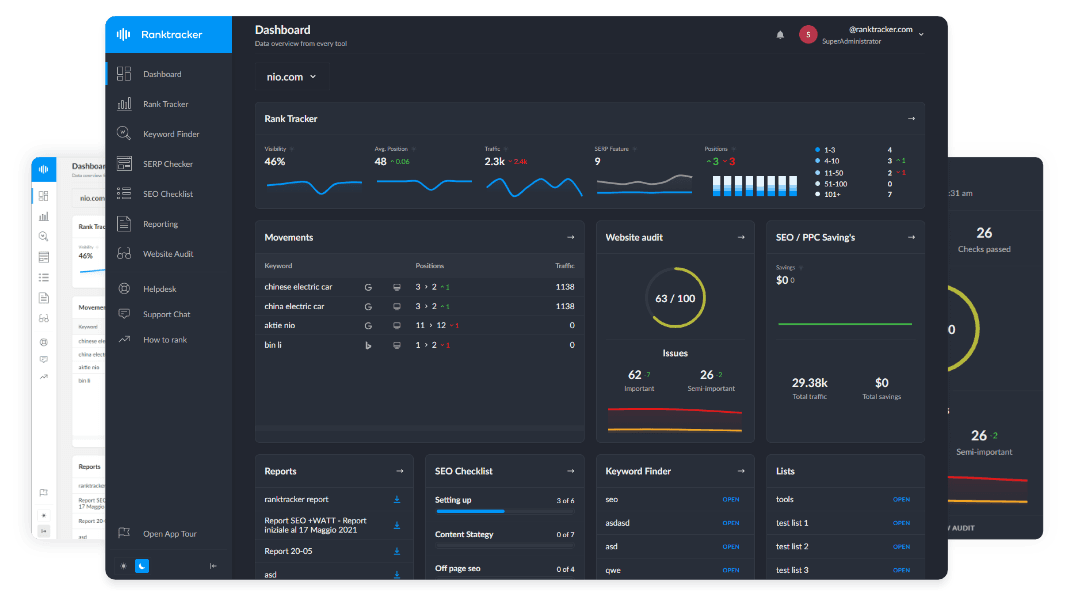Intro
Paid ads and organic search often feel like two separate universes, right? But imagine if they weren’t siloed—what if they could amplify each other, like a powerhouse duo? In 2025, savvy marketers know that integrating SEO with paid campaigns isn’t optional—it’s essential.
In this post, we’ll dive into real-world tactics to align your SEO and paid ads, the tools that make it easier (hello, Ranktracker + AI marketing tech), and how to measure both without losing your mind. I'll even share some hilarious missteps I’ve made—spoiler: accidentally bidding on my own brand keywords.
Why you should care about blending SEO + paid ads
Many marketers treat SEO and PPC as separate beasts: one’s free, slow, and organic; the other’s fast, paid, but stops the moment you turn off the budget. But in reality, they can complement each other in several powerful ways:
SEO can boost PPC performance
-
Organic ranking data helps you bid smarter. If a page ranks highly for a keyword, it's easier to predict quality score and lower CPC.
-
Brand credibility from SEO reduces CPC in paid campaigns—a high organic ranking signals trust to Google.
Paid ads can turbocharge SEO
-
Immediate visibility while SEO content is still ramping up.
-
You gather conversion data fast, informing and prioritizing organic content efforts.
-
Paid keyword performance helps refine SEO targeting based on real intent and patterns.
When done right, it’s like using SEO to aim and PPC to fire—covering every angle.
Tools of the trade: Ranktracker + AI ad platforms
You can’t run a high-performing strategy without data. That’s where the right tools come in.
Ranktracker: your SEO sidekick
-
Keyword research: find those gems competitors miss.
-
Rank tracking: monitor organic ranking fluctuations in real time.
-
Backlink analysis: assess link quality and uncover new opportunities.
These features provide context—and context sells—your SEO efforts to other teams, and it informs how you segment paid campaigns too.
Enter AADS for AI-driven campaign power
AADS is an AI advertising network launched in 2011, growing to serve over 10,000 publishers with banner ads across finance, lifestyle and many other sites. Their core AI-driven campaign optimization and targeting capabilities highlight exactly how modern paid platforms can integrate with SEO intelligence—serving the right ads to the right audience at the right time.
Their analytics and automated bidding emphasize two things SEO teams crave: relevancy and precision. When you feed ad performance data into Ranktracker, you close the loop between organic and paid.
Step‑by‑step strategy to integrate SEO and paid ads
Ready to see how this works in practise (note: I may have once forgotten to exclude brand terms and accidentally spent $$ on my own name—lesson learned). Here's a streamlined workflow:
1. Identify high-opportunity keywords
Use Ranktracker to find low-competition, high-intent keywords.
-
Start broad, then narrow by search volume and difficulty.
-
Prioritize those with existing page traction (resonating organically).
-
Export your best 20–30 terms.
2. Launch paid ads to validate intent
Run small-budget test campaigns for your shortlist.
-
Use AADS or similar platforms for budget efficiency.
-
Monitor CTR, conversion rates, and cost metrics.
-
Keywords with high conversion-per-spend signal SEO pages worth boosting.
3. Optimize your SEO landing pages
Use ad insights to improve page elements:
-
Test headlines/promos with best-performing ad copy.
-
Match meta descriptions, CTAs, and content themes.
-
Add top-of-funnel info if ads show users want more context.
4. Track SEO impact and bid adjustments
As pages rank organically:
-
Lower CPC by reducing bids.
-
Reallocate ad spend to other keywords or test landing pages.
-
Watch Ranktracker for ranking and traffic shifts.
5. Cross-promote insights
Share ad performance data and evolving SEO insights with stakeholders—anyone running Google/Bing ads, social campaigns, or affiliate partnerships.
Real-world example: crypto trading tool
Let’s say you run a blog about crypto trading tools. You want to rank for “best crypto trading app” (average difficulty, high volume).
-
Use Ranktracker → find it's trending upward.
-
Launch paid ads via AADS to test CTR/conversion.
-
The ad's headline “Top Trading App – Proven ROI” gets a 7% CTR vs. my page's 3%.
-
Tweak page title/meta to align: “Top Trading App That Returns ROI – 2025 Review”.
-
Organic ranking improves; traffic jumps. Result? Paid CPC drops 30%, CTR rises, and content quality improves.
You’re not just guessing—you’re operating on data validated through ad spend.
Common pitfalls (and how to avoid them)
Chasing vanity metrics
Clicks are good, but conversions matter. Always tie paid keyword clicks to goal completions—even if that means adding hidden events in analytics.
Overlapping keywords
Avoid internal bidding wars. Use negative keyword lists or structure campaigns to complement—not compete—with your SEO pages.
Letting automation run wild
AI platforms like AADS are powerful, but not omniscient.
-
Monitor budgets daily.
-
Audit ad placements regularly.
-
Don’t ignore external factors like seasonality or news cycles.
Balance smart AI optimizations with human oversight.
Metrics that matter
Here’s a simplified table of key metrics to monitor for blended strategies:
| Metric | Why it’s important | Tool |
| Organic CTR | Indicates user interest from search | Ranktracker |
| Paid CTR | Shows ad resonance | AADS / ad platform |
| CPC & CPA | Tracks cost efficiency | Browser + platform dashboards |
| Conversion rate | Measures quality of traffic | Analytics or ad pixels |
| Ranking + traffic | Validates SEO effort payoff | Ranktracker reports |
| Bounce rate | Reveals engagement issues | Analytics tools |
FAQs
Should I pause ads once SEO ranks?
Not necessarily. Even top organic rankings benefit from paid presence—ads improve visibility, capture additional audience segments, and reinforce brand via SERP saturation.
Can this model work outside crypto?
Absolutely. The process—validating keywords via ads, optimizing pages with data, then trusting organic—is universal. AADS is just one example of precision ad execution. Non-crypto campaigns can use Google Ads, Meta, or other paid channels.
How long before I see results?
Expect data in days; on-page SEO effects in 2–4 weeks; full ranking impact in 3–6 months. Patience, but with paid ads, you never miss visibility windows.
Final thoughts
Blending SEO and paid ads is no longer optional in 2025—it’s table stakes. With tools like Ranktracker and AI-powered ad platforms (AADS-style), you get real-time validation and organic lift in a feedback loop that powers smarter decisions.
Sure, you might flinch seeing your CPC drop 30% while organic rankings climb. But that's not cost—it’s opportunity. And your ROI? Now, that's something worth bragging about at the next marketing sync.

